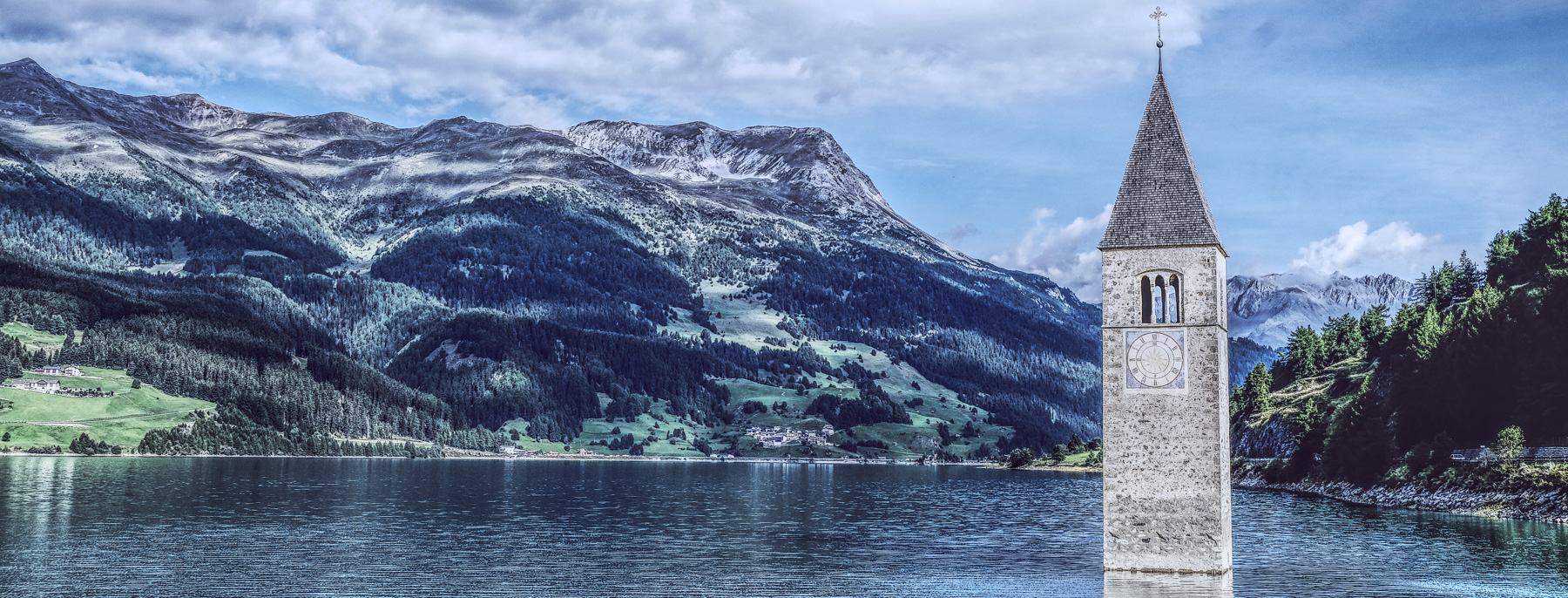DER VERSUNKENE TURM IM RESCHENSEE, DAS WAHRZEICHEN DES VINSCHGAU
Das Wahrzeichen des Vinschgau ist zugleich märchenhaft und faszinierend: Aus dem 6 km langen, klaren Reschensee, vor der Bergkulisse des urigen Langtauferer Tals, ragt einsam ein versunkener Kirchturm. Doch die Geschichte hinter dem bekannten Postkartenmotiv, dem „Turm im See“, ist weit weniger idyllisch: Das romanische Kirchlein aus dem 14. Jahrhundert ist stummer Zeitzeuge einer verantwortungslosen See-Stauung kurz nach dem Ende des Zweiten Weltkrieges.
Seit 1922 wütete in Italien und somit auch in Südtirol der Faschismus. Im Jahre 1939 reichte der Großkonzern "Montecatini" ein Projekt ein, den Reschen- und Graunersee um 22 Meter zu stauen. Die Bevölkerung von Reschen und Graun wurde dabei völlig übergangen. Der ausgebrochene zweite Weltkrieg verzögerte dann allerdings das bereits angefangene Bauvorhaben. Die Bewohner des Oberen Vinschgaues glaubten damit, dieses Schreckgespenst für immer los zu sein. Doch zur Bestürzung der betroffenen Einwohner wurde 1947, nur zwei Jahre nach Kriegsende, von Seiten der Montecatini bekannt gegeben, dass die Arbeiten am Stauprojekt unverzüglich wieder aufgenommen werden.
1950 im Sommer war es nun soweit. Die Schleusen wurden geschlossen und der Reschensee gestaut. 677 Hektar Grund und Boden wurden überflutet, beinahe 150 Familien wurden ihrer Existenz beraubt, und die Hälfte davon zur Auswanderung gezwungen. Die Entschädigungen waren sehr bescheiden. Die Bewohner von Graun hatte man dann notdürftig in ein Barackenlager am Ausgang des Langtauferertales, das man eiligst aufgestellt hatte, untergebracht. Durch das faschistische Stauprojekt verloren hunderte Familien aus Graun und Reschen ihre Existenz.
Heute steht der Turm im Reschensee unter Denkmalschutz und ist Wahrzeichen der Gemeinde Graun und ein Publikumsmagnet.
Mehr Informationen zur Geschichte von Alt-Graun und dem Turm im Wasser: www.obervinschgau.org
(Quelle: http://www.vinschgau.net/de/reschenpass/kultur-kunst/sehenswuerdigkeiten/turm-im-see.html)
THE SYMBOL OF VENOSTA VALLEY: THE SUBMERGED STEEPLE IN RESIA LAKE
The symbol of Venosta Valley is quite fascinating and rather like a fable. A solitary church steeple emerges half out of the clear waters of the 6 km long Resia Lake, against the majestic background of the wild Langtaufers Valley. However, the story behind this postcard-like image is far less idyllic and the romantic 14th Century church bears testimony to the irresponsible decision of the State to locate a dam there after the end of the Second World War.
As from 1922, Fascism had taken hold in Italy, including South Tyrol. In 1939, the Montecatini conglomerate began the construction of a of 22-meter deep dam project in Resia/Reschen, with complete disregard for the sensibilities and remonstrations of the local South Tyrolean population. Construction was suspended after the outbreak of the War and it was hoped that this would mark the end of the project. But in 1947, just two years after the end of the War and much to the dismay of the local population, Montecatini announced that work on the construction of the dam was to be resumed.
By the summer of 1950, it was all over. The locks had been tightened and the water was rising, flooding 677 hectares of land affecting 150 families, half of which were forced to emigrate. Compensation was meagre and the inhabitants of the town of Curon/Graun, which was completely flooded, were housed in temporary accommodation – basic shacks located at the entrance of the Vallelunga/Langtaufers. The dam was the product of fascism and through it hundreds of families lost the basis of their livelihood.
The half-submerged church steeple in the Resia Lake has since been declared a protected historical artefact, becoming a tourist attraction and thus symbolizing the legacy of old Curon.
(Source: http://www.vinschgau.net/en/resia-pass/culture-arts/places-of-interest/tower-in-the-lake.html)

